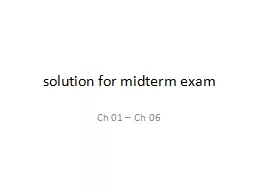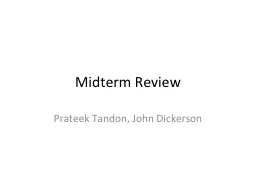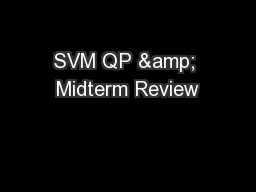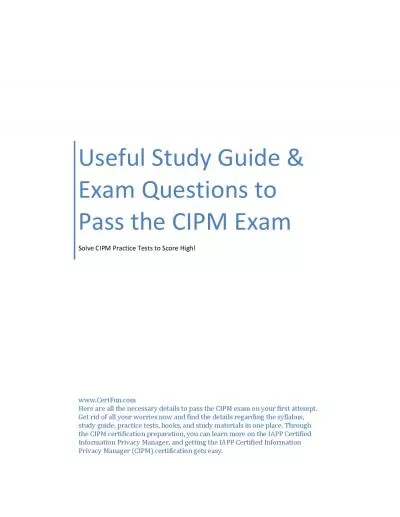PPT-solution for midterm exam
Author : danika-pritchard | Published Date : 2019-11-27
solution for midterm exam Ch 01 Ch 06 1 Calculate each value requested for the following set of scores 2 points each X 1 3 0 2 and Y 5 1 2 4 a ΣX 6
Presentation Embed Code
Download Presentation
Download Presentation The PPT/PDF document "solution for midterm exam" is the property of its rightful owner. Permission is granted to download and print the materials on this website for personal, non-commercial use only, and to display it on your personal computer provided you do not modify the materials and that you retain all copyright notices contained in the materials. By downloading content from our website, you accept the terms of this agreement.
solution for midterm exam: Transcript
solution for midterm exam Ch 01 Ch 06 1 Calculate each value requested for the following set of scores 2 points each X 1 3 0 2 and Y 5 1 2 4 a ΣX 6. . information. department. of . conservative. . dentistry. 2013/2014 1. semester. Department. of . Conservative. . Dentistry. 2013/14 1. . semester. Attendance. . list. . taken. . every. . Prateek Tandon, John Dickerson. Basic Uninformed . Search . (Summary). b = branching factor. d = depth of shallowest goal state. m = depth of the search space. l = depth limit of the algorithm. CSP Solving - Backtracking . Rob Hall . 10/14/2010. 1. This Recitation. Review of Lagrange multipliers (basic undergrad calculus). Getting to the dual for a QP. Constrained norm minimization (for SVM). Midterm review. 2. Minimizing a quadratic. Instructor: Colin Walker. Today. Contact Info. Class rules. Course Description. Textbook. Assessment. ~ sign out on the Excel Spreadsheet. ~ Any student not signed up?. Contact. Email: . colinjerwalker@gmail.com. 15-213: Introduction to Computer Systems. Recitation 8: Monday. , Oct. 19, 2015. Ben Spinelli. Agenda. Midterm Logistics. Brief Overview of . some. topics. Practice Questions. Midterm. Tues Oct 20. th. Email. : . a.pipino1@campus.unimib.it. ; . alessandra.pipino@mib.infn.it. Midterm Seminar Day - 31. st. March 2015. System-level and circuital design of receivers for wireless communication applications. of 80 Freshman Student on the Midterm Algebra Exam . 82 51 92 89 63 67 64 82 . 57 96 81 76 94 94 68 68 . 75 53 76 82 62 71 72 86 . 50 79 84 80 77 77 84 93 . 90 63 63 76 65 72 83 59 . 62 76 71 32 93 57 95 54 . English language skills department. KSU Preparatory year. AY 2014-2015. Midterm CBT - EXAM Dates. Day. Timing. Sat. April 4. th. , 2015 . (Hum., Parallel Hum.). 08:00. - 10:00. 10:00 - 12:00 . ----------------------------------. Learning for NLP Midterm Review: Midterm next Tuesday Homework back Thanks for doing midterm exam! Some very useful comments came in. Today Statistical NLP Machine Learning for NL Tasks Some form of classification Learning for NLP Midterm Review: Midterm next Tuesday Homework back Thanks for doing midterm exam! Some very useful comments came in. Today Statistical NLP Machine Learning for NL Tasks Some form of classification kindly visit us at www.nexancourse.com. Prepare your certification exams with real time Certification Questions & Answers verified by experienced professionals! We make your certification journey easier as we provide you learning materials to help you to pass your exams from the first try. kindly visit us at www.nexancourse.com. Prepare your certification exams with real time Certification Questions & Answers verified by experienced professionals! We make your certification journey easier as we provide you learning materials to help you to pass your exams from the first try. kindly visit us at www.examsdump.com. Prepare your certification exams with real time Certification Questions & Answers verified by experienced professionals! We make your certification journey easier as we provide you learning materials to help you to pass your exams from the first try. Professionally researched by Certified Trainers,our preparation materials contribute to industryshighest-99.6% pass rate among our customers. Here are all the necessary details to pass the CIPM exam on your first attempt. Get rid of all your worries now and find the details regarding the syllabus, study guide, practice tests, books, and study materials in one place. Through the CIPM certification preparation, you can learn more on the IAPP Certified Information Privacy Manager, and getting the IAPP Certified Information Privacy Manager (CIPM) certification gets easy.
Download Document
Here is the link to download the presentation.
"solution for midterm exam"The content belongs to its owner. You may download and print it for personal use, without modification, and keep all copyright notices. By downloading, you agree to these terms.
Related Documents














